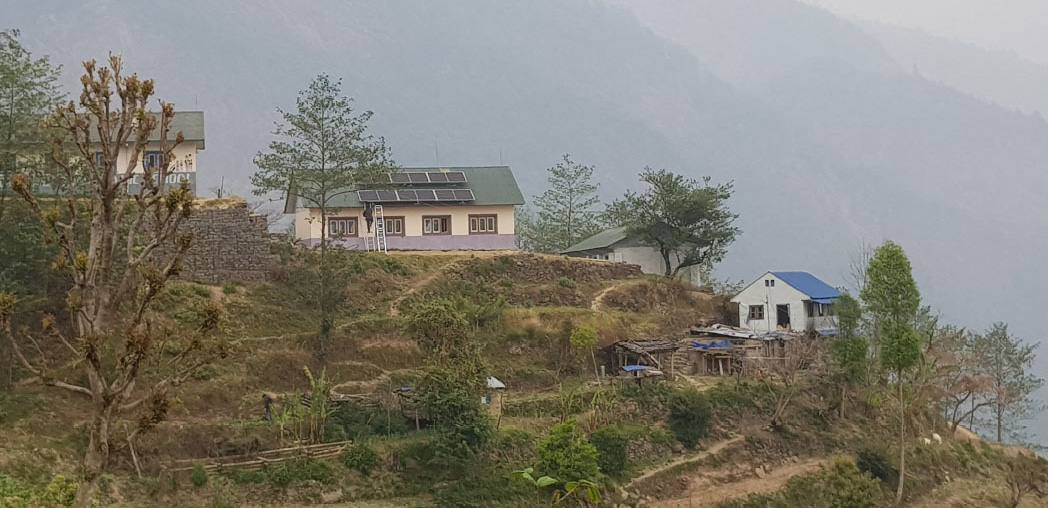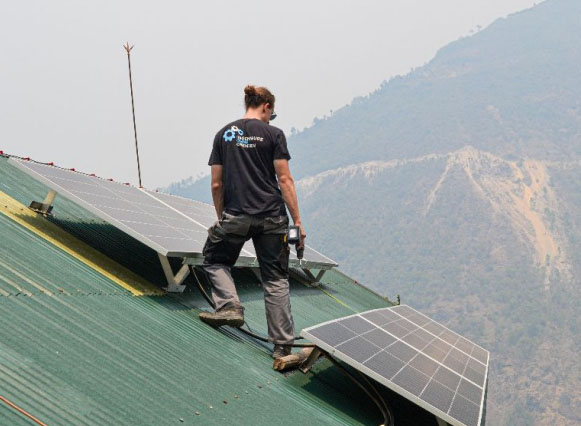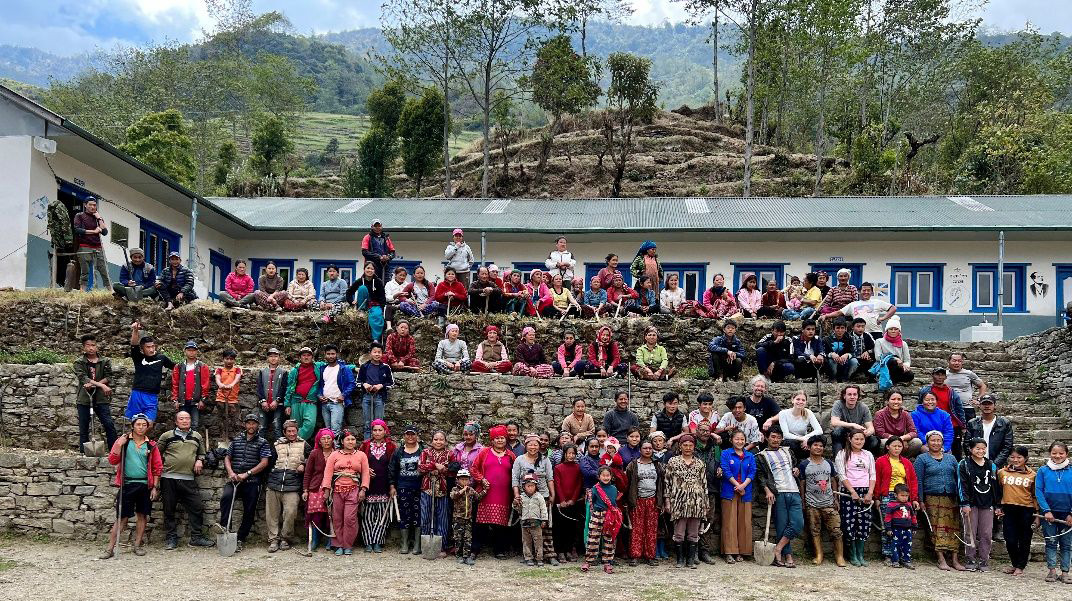The power often failed at a primary school in a remote Nepalese village. Even worse, the school was vulnerable to frequent lightning strikes. To improve the learning conditions and safety, Engineers Without Borders Germany upgraded the school’s electrical system and installed lightning protection, new solar panels, batteries, and wiring. Now, students can work without power outages or fear of lightning strikes.
Thulodhunga is a remote Nepalese village in the rugged foothills of the Himalayas. Though located not far from Mt. Everest, the community is off the beaten track for tourists and the generous donations they often make to help improve the lives of the people of Nepal.
With about 1,000 residents and 150 houses clinging to sheer hillsides, Thulodhunga survives on subsistence farming in neat rows of terraces that climb up the steep slopes. The village has potable drinking water and is connected to neighboring villages by gravel roads, but without a connection to a national grid, the electrical power is intermittent. Instead, Thulodhunga gets its energy from three islanded power grids that use solar energy and high-head hydropower — or water that drops 100 meters or more — to generate electricity in different parts of the village. The high-head hydropower installations harness small but powerful streams that rush down the mountainsides and generate power from small turbines.

Nepal’s rural schools often require earthquake-proofing and electrical upgrades to improve learning conditions and safety, according to Engineers Without Borders Germany (EWB), a non-profit and independent development cooperation organization with a strong focus on improving conditions in schools in developing countries. One school, the Shree Chandrodaya Basic School, is perched high on a steep and narrow ridge, open to the elements on all sides and vulnerable to recurring lightning strikes. It is also subject to frequent power outages, interrupting the children’s studies and preventing evening activities.
To overcome these difficulties, the non-governmental organization Classrooms in the Clouds asked EWB to help support the school in Thulodhunga. The school’s challenges were a good match for the organization’s expertise in renewable energy, electrical improvements and training in remote, underserved communities. The Shree Chandrodaya school has about 120 students ranging in age from five to 14.
EWB’s top priorities for the school were to supplement the local power systems, provide a reliable and sustainable power supply to improve classroom lighting, and enable greater use of computers and other electronic media. Importantly, EWB wanted to ground the school’s electrical system to protect it from lightning strikes and provide “safe rooms” where children could gather for protection from lightning strikes during dangerous thunderstorms.
Finally, EWB sought to provide education and training in renewable energy and basic electrical engineering to town residents so they could monitor and maintain their off-grid power systems.
The first steps for EWB were to work with local suppliers to purchase materials for the project, collaborate with local builders to clarify the project plan and coordinate with Thulodhunga officials.
“We learned how to manage the costs of a fairly complex project and that it was important to coordinate the implementation with our local project partner in advance,” said Lennart Götz, electrician and electrical engineering student.
First, the team dug a trench around the school for the grounding wires and installed new wiring inside the school. Then, they built and commissioned a three-kilowatt (kW) solar photovoltaic (PV) system with the help of a group of volunteer trainees.

Ultimately, EWB funded the electrical upgrade for about $26,340 (USD), with half allocated to the solar PV system and its implementation and the other half used for the grounding, wiring, lightning protection and other expenses. EWB completed the project in seven weeks, providing the school with th 3 kW PV system, a 5 kW inverter and a 1.2 kWh lead-acid battery bank to provide backup power.
“We used lead-acid batteries because it’s our policy to purchase materials in the countries where we work. If we had chosen a European lithium-ion battery, it would have been impossible to replace locally,” Götz said. Lead-acid batteries can be demanding to maintain, so Götz explained that they chose gel rather than water-filled batteries because they are easier to maintain. “Although,” he added, “you always have to watch the voltage and make sure that all of the batteries are charged to the same level.”
Electrical engineer Rudy Kothe said he used a power logger at the beginning of the project to evaluate the electrical load and then modeled the entire project in HOMER® Pro software. He estimated a potential three-day power loss in the event of bad weather or a local grid failure and designed the battery bank to fit that scenario. If the battery voltage is too low and the sun is not shining, the system’s smart inverter automatically switches back to the local grid. Also, EWB can monitor the system remotely.
“It is already the monsoon season, and we can see that the system at the school has been operating successfully on 100% solar,” Kothe reported.
EWB also supervised the digging of a trench around the entire school for the grounding wires and provided lightning rods, wiring for the internal electrical system and grounding for all the wiring in the school. Lightning is a devastating hazard in Nepal and a major cause of fatalities because of how the mountainous terrain interacts with moisture from the Indian Ocean, according to the Journal of Weather, Climate and Society. It was a top priority for EWB to protect the highly exposed school from lightning.
The final phase of the project was training. Kothe and Götz provided a week of hands-on education to local volunteers on operating and maintaining the school’s renewable energy system. The volunteers learned the basics of electrical engineering and how the PV system works. EWB also trained one person who is solely responsible for the proper function of the PV system and keeping the batteries in good condition.

With this new electrical system provided by EWB, the children of Thulodhunga now have electricity in every classroom, better lightning protection, “safe rooms” to help protect them from dangerous thunderstorms, and the opportunity to implement electronic devices that will significantly improve their access to education in a wide range of subjects.
Learn More about HOMER Pro

UL Solutions’ HOMER® Pro is the leading pre-feasibility design software for modeling microgrids, with more than 250,000 users in more than 190 countries. It provides engineering and financial analyses of remote, off-grid and grid-tied complex distributed energy systems, helping reduce financial risk for owners and developers. Learn more about HOMER Pro and download a complimentary trial.
